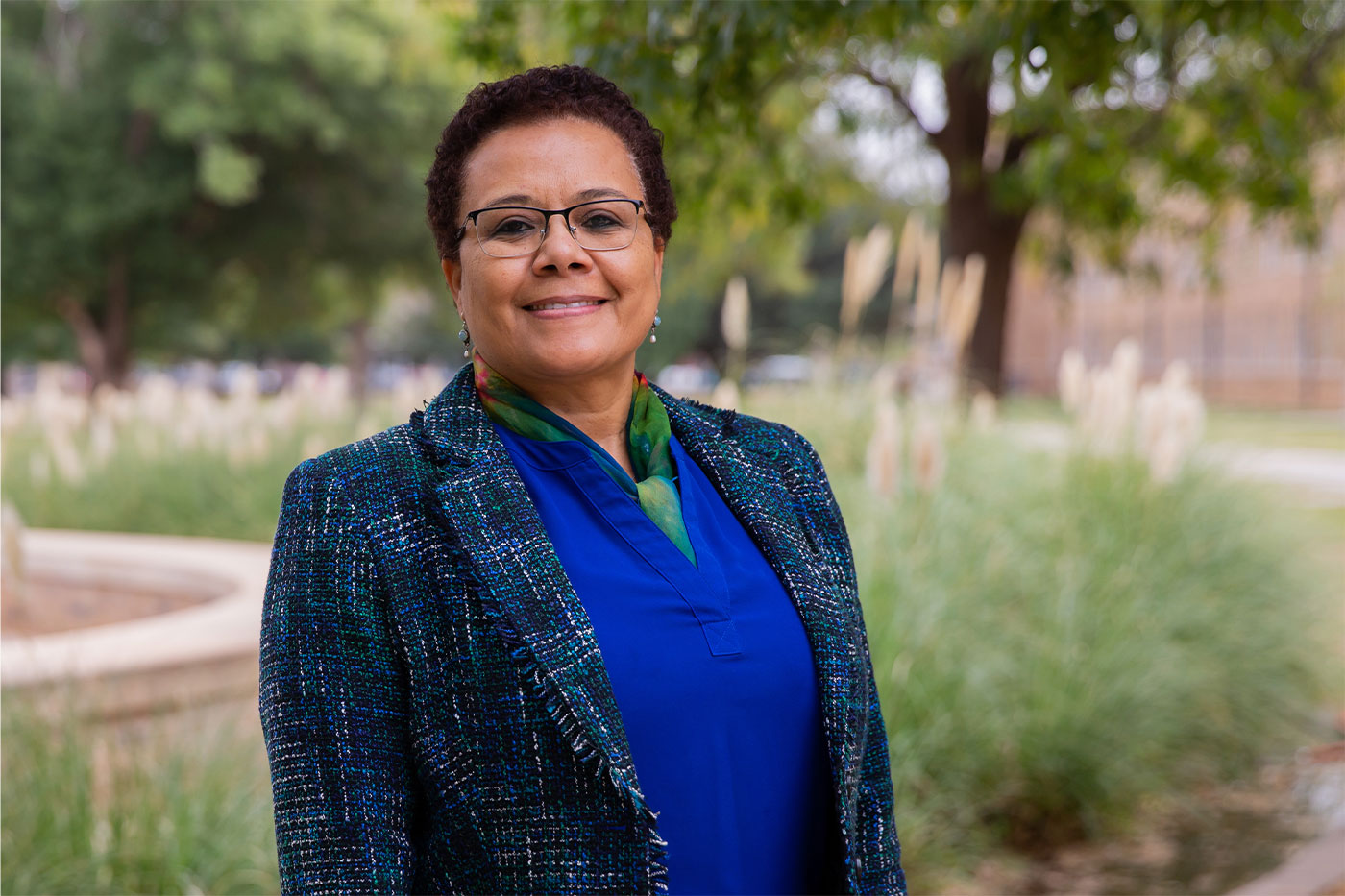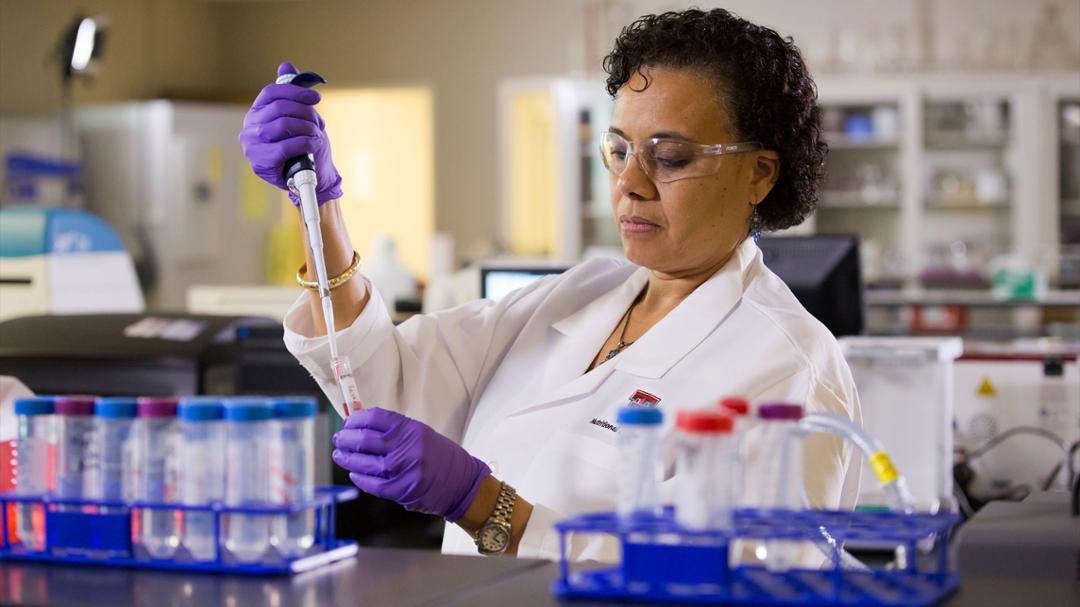Naïma Moustaïd-Moussa is one of approximately 500 scientists to be named a Distinguished Fellow of the American Society for Nutrition.
Long before Naïma Moustaïd-Moussa ventured to the United States, eventually reaching Texas Tech University’s Department of Nutritional Sciences as a professor, part of her daily routine as a child in Morocco included a visit to her local market to pick up fresh meat and vegetables.
The only canned food item her family used was tomato paste. But that all changed when Naïma traveled to France in the 1980s to continue her undergraduate studies, where she had immediate access to a wide swath of fruits, vegetables and even fish that came tightly packed in aluminum.
Naïma distinctly remembers tasting canned green beans for the first time, and how mushy and salty they were as opposed to the satisfying crunch fresh ones provided.
Though the 21-year-old initially went to France focused on studying cell biology and physiology, it would be in the world of nutrition where Naïma established herself. Decades of pedagogy and research would elevate her to exclusive status, as in early June, Naïma joined a selective list of scientists to be named Distinguished Fellows of the American Society for Nutrition (ASN).
The ASN’s flagship annual meeting, NUTRITION 2025, also marked her transition from vice president to president of the ASN Board of Directors for the 2025-2026 year.
“Becoming president is a great honor, and it’s a big responsibility because you’re representing nutritional science in the U.S.,” Naima says.

Much of her physiology studies were related to metabolism and nutrition, such as her biochemistry classes’ coverage of lipids, or fat molecules. Naïma was fascinated by lipids’ complexity and importance, in that a simple change to a molecule could drastically affect its structure and thus how it reacts to signals that come into cells and tissues from outside forces.
High amounts of fat are first stored in the fat tissue, but when there is excess beyond what the adipose (fat) tissue can store, the fat lands in other organs like the liver, kidney and pancreas and can change their metabolism and reduce their functions.
She followed this thread as she pursued her master’s and doctoral degrees in endocrinology, or the study of hormones, from the Sorbonne University (formerly the University of Paris VI – Pierre and Marie Curie Campus). Naïma ventured further into the realm of nutrition and obesity while investigating adipose tissue metabolism in rodent feeding studies at France’s INSERM, or National Institute of Health and Medical Research. She also studied how fat cells develop and respond to nutrients and hormones.
“That rat model studied at the time had some genetic defects, so they were trying to understand the basis for it,” Naïma recounts. “When I got through that lab, when I completed my Ph.D., I learned that nutrition and genetics are important when it comes to obesity and diabetes.”
Her next stage in education took her across the Atlantic in the early 1990s for a postdoctoral fellowship at the Harvard School of Public Health’s Department of Nutrition. Boston was where Naïma experienced her biggest culture shocks related to food; she especially recalls the large serving and plate sizes and people eating out much more than at home.
“In Morocco specifically, it’s different because the whole family shares one big main dish with side salads during meals,” Naima says. “We also rarely ate out, but that has changed there, too, to some extent.”
After Harvard, Naïma became a faculty member and developed her first independent research at the University of Tennessee, Knoxville during the origins of the obesity epidemic, which gained prevalence in the 1990s and 2000s.
Her initial research into lipids had already started her on this path, but as she spent more time in the United States, she grew a stronger interest and scientific curiosity to understand diabetes and obesity, how both conditions evolve in the body, their connection to people’s everyday diet, their environment or genetic makeup and the role of fat tissue in those diseases.
With the understanding that fat tissue is a part of the endocrine system, Naïma’s research continued to progress, along with science and society’s realization that obesity is related to genetic and environmental factors as well as diet and physical activity.
There are numerous explanations for weight gain, including whether someone lacks leptin or receptors for leptin, a hormone produced by fat cells that regulates appetite; they are a person experiencing menopause; they have a non-favorable type of bacteria housed in their gut, they simply have a genetic addiction to food or how their brain regulates their appetite.
The American Medical Association only recognized obesity as a disease in 2013, representing a cultural shift.
“The research has helped advance our knowledge, and we understand now that obesity is a very complex disease,” Naïma says. “It’s due to genetic, environmental, lifestyle and social factors.”
Naïma saw those environmental and social factors play out firsthand when she moved from New England to Tennessee, and furthermore in Lubbock when she arrived in 2012 as a Senior Strategic Hire in Nutrition and Obesity.
Once at Texas Tech, Naïma added to her already impressive career of teaching and investigation.
In 2013, she founded what became the Obesity Research Institute (ORI), which she co-directed through May 2025 with Jannette Dufour, a professor and chair of the Department of Cell Biology & Biochemistry in the Texas Tech University Health Sciences Center. The ORI was renamed the Center of Excellence in Obesity and Cardiometabolic Research and is now co-directed by Dufour and Kembra Albracht-Schulte, who is also an assistant professor in Texas Tech’s Department of Kinesiology and Sports Management.
Naïma also leads the Nutrigenomics, Inflammation and Obesity Research Lab in nutritional sciences, which focuses on adipose tissue growth and inflammation and the subsequent impact on metabolic health, using dietary bioactive compounds like sorghum and tart cherries in the process. Countless students have worked under Naïma in Tennessee and Texas, to the extent she has amassed five U.S. patents and published roughly 200 peer-reviewed papers funded by federal government agencies, national research associations and more.
Naïma was also named a Horn Distinguished Professor in 2021. Though she is quick to acknowledge the importance of the hard work her students and collaborators have contributed to her research, her success is no doubt anchored by a steadfast commitment to simple scientific methodology.
Whenever she or a student is interested in a project, the first step is to head to the National Library of Medicine’s PubMed or other databases of publications to find and read the literature on that subject. Avoiding reinventing the wheel is key, as is identifying gaps or questions that are unanswered and compiling all the questions into a hypothesis.
Next is study design, which requires its own abundance of detailed questions to decide what is physiologically relevant, what outcomes need to be measured and how. Naïma also emphasizes considering whether outside expertise is necessary to form a better proposal before seeking funding.
This routine has led to several moments Naïma remembers fondly, such as displaying fish oil’s efficacy in reducing inflammation and fat cell size, the latter of which leads to cells that are healthier and more sensitive to insulin. Another example is her lab work on tart cherries, using different models including worms that showed lifespan extension after being fed the cherries.
She was also part of a group of the earliest researchers to identify angiotensin II, which increases blood pressure, in human fat tissue and not just in mice.
Additionally, her group made a significant contribution in conducting animal studies while investigating why many people who have obesity also have hypertension. By engineering mice to have larger fat cells, the cells produced more angiotensin that traveled into the bloodstream and caused high blood pressure concurrent with increased fat mass, inflammation and obesity.
Their research also demonstrated that by treating fat cells with omega-3 fatty acids, the cells produced less angiotensin, another major discovery.
“People think fat tissue is just an organ, but over the past three decades, we’ve known through research in my lab and others that fat tissue is an important, dynamic tissue that contributes to whole body homeostasis (regulating a state of balance),” Naïma says. “Fat cells, depending on their quality, can make both good and not-so-good substances that affect the metabolism and function of other organs.”
Mentoring students through the high-level research she’s done and preparing them for their careers is one of her biggest passions, she adds. Naïma beams as she states her lab has produced several doctoral students, who all emerged from her rigorous approach to studies and went on to hold positions as postdocs at top institutions, faculty and in the industry.
She also trains many undergraduates in nutritional sciences, not only in research but professionally as the department contributes support for travel to conferences and competitions. She is currently a principal investigator for a USDA grant in which students obtain intense research training in food, nutrition and agriculture areas with Texas Tech faculty, combined with an internship with the Texas A&M AgriLife Extension Service working alongside Extension community educators.
Networking is just as important. Naïma puts significant energy into connecting students to the right people in education or the industry, in addition to mentoring graduate students and postdocs to be effective guides by pairing them with undergraduates.
As if those priorities aren’t exhausting enough, Naïma has also led the Texas Tech System-Wide Institute for One Health Innovation since July 1, 2024, when she was announced as the inaugural executive director.
A collaborative approach that recognizes the health of animals, humans and the environment as interconnected, Naïma wants to broaden the scope of nutrition through the One Health lens as she steps into her new role of ASN president.
In practice, One Health is closely related to nutrition; this focus means investigating agricultural practices and production systems, how soil or crop quality are affected by these decisions, and in turn, how products affect human health. Pressing questions include how to achieve food and nutrition security, how to produce crops and food that use less water and how to avoid microplastics in packaging, as these microplastics can be stored in fat tissues and arteries and travel into the brain when ingested.
Another important area of One Health is infectious diseases especially those transmitted from vectors to humans or animals or transmitted from one species to another. Naïma anticipates society needing to address the resurgence of avian influenza and other emerging diseases, as well as food and water safety.
With a dynamo like Naïma at the helm, One Health appears poised to point the world in a positive direction.
“In order to achieve health for all, we have to use the One Health approach,” Naïma says. “That’s the only way to do it.”

